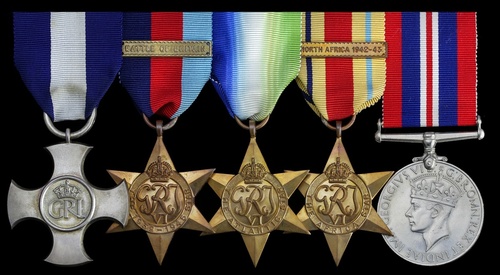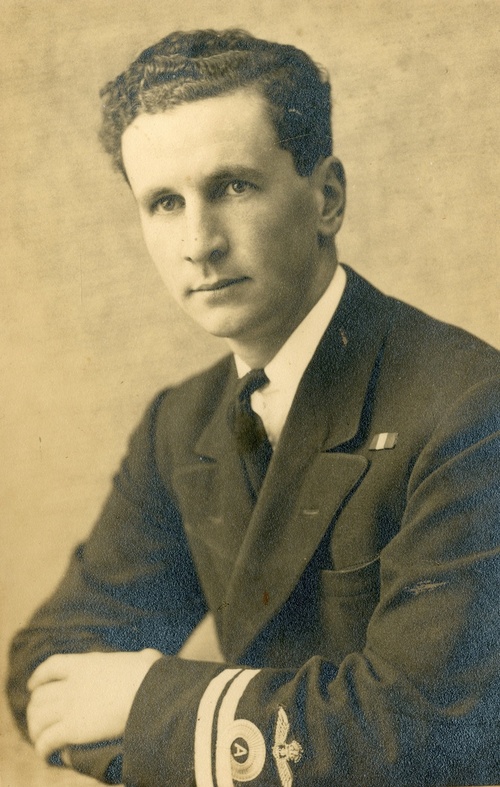Auction: 18001 - Orders, Decorations and Medals
Lot: 35
Sold by Order of a Direct Descendant
'In the eyes of the world the Battle of Britain is, and always will be, an R.A.F. victory and the contribution and sacrifice of the 'Few' is something that is indisputable. However, the Royal Navy, and those with an interest in Naval aviation history, should never forget the bravery of the few within the 'Few' who fought in Naval uniform.
Seven Naval pilots were killed and two wounded during the Battle of Britain and whilst all 56 Naval aviators are listed on the Battle of Britain memorial in London, the contribution made by the Royal Navy is rarely recognised. In the iconic films 'Battle of Britain' and 'Reach for the Sky', despite Douglas Bader having three Naval officers in his squadron, including his wingman 'Dickie' Cork, no reference is made to them.'
The Fleet Air Arm Officers' Association website, refers.
The exceptional Second World War D.S.C. group of five awarded to Lieutenant (A.) D. A. Hutchison, Fleet Air Arm, one of the Senior Service's 'few within the Few' who flew Spitfires of No. 74 Squadron out of Hornchurch at the height of the Battle of Britain
He was subsequently decorated for his gallant deeds as a Martlet pilot in 802 Squadron in November 1941, when, operating from the escort carrier H.M.S. Audacity during a Gibraltar bound Convoy HG 76, he gained the rare accolade of shooting down a Focke-Wulf 200 Condor: three days later he survived the Audacity's loss when she was torpedoed west of Cape Finisterre
His luck, however, ran out after he had converted to Sea Hurricanes and joined the escort carrier Avenger: she blew up after being torpedoed off Gibraltar on 15 November 1942, only 12 men of her complement being rescued
Distinguished Service Cross, G.VI.R., hallmarks for London 1942, the reverse officially dated '1942' and privately engraved, 'Lt. (A.) D. A. Hutchison, R.N., H.M.S. Audacity', in its Garrard & Co. Ltd. case of issue; 1939-45 Star, clasp, Battle of Britain; Atlantic Star; Africa Star, clasp, North Africa 1942-43; War Medal 1939-45, these last four in their original addressed forwarding box addressed to the recipient's father in Kenya, and further inscribed 'D.N.A. (Wills) 54/171', extremely fine (5)
D.S.C. London Gazette 10 March 1942:
'For bravery and skill in action against enemy aircraft and in the protection of a convoy against heavy and sustained enemy attacks.'
David Alexander Hutchison was born on 12 January 1919 and, having attended Stowe, joined the Royal Navy as a Midshipman (A.) in September 1939. Advanced to Sub. Lieutenant in the following year, he trained as a pilot at Belfast and Netheravon and was awarded his 'Wings' in late June 1940.
Battle of Britain
The involvement of Fleet Air Arm pilots in the Battle of Britain in the summer of 1940 is little known. To quote the Fleet Air Arm's Officers Association website, Winston Churchill's famous words of praise for the 'Few' 'immediately conjure up images of plucky R.A.F. chaps running to their Spitfires to go and give 'Jerry' a damn good thrashing. However, it is frequently overlooked that 56 Fleet Air Arm pilots also took part in the Battle of Britain with four becoming fighter aces. Although rarely acknowledged, three Naval pilots also flew with the famous 242 Squadron commanded by the legendary Douglas Bader.'
The young Naval aviators who took part in the Battle of Britain between July and October
1940 saw some of the fiercest fighting of the battle: 23 Naval pilots served with twelve R.A.F. Fighter Command Squadrons, flying Spitfires and Hurricanes, and a further 33 served with 804 and 808, the two Fleet Air Arm 'Battle of Britain Squadrons' who operated under Fighter Command, providing dockyard defence.
Hutchison was attached to the R.A.F. at the end of June 1940, when he arrived at Aston Down and converted to Spitfires. In the first week of July, he joined No. 74 Squadron at Hornchurch, and he remained similarly employed until removing to No. 804 Squadron, Fleet Air Arm (F.A.A.) at the end of August. Thereafter, for the remainder of the Battle, he flew Gladiators.
In common with his fellow F.A.A. pilots who joined frontline R.A.F. squadrons, he would have retained his naval uniform - and was paid by the Admiralty - but in all operational respects he became a member of his R.A.F. squadron. Nonetheless, he and his fellow F.A.A. pilots retained their identity as naval aviators: Sub.-Lt. (A.) R. E. Gardner painted Nelson's 'England Expects' flag hoist on his 242 Squadron Hurricane, and Sub.-Lt. (A.) A. G. Blake with 19 Squadron predictably gained the nickname 'Admiral'.
Flight of the Condor
In December 1940, Hutchison joined No. 802 Squadron, F.A.A., then forming at Donibristle for the escort carrier H.M.S. Audacity. He converted to Martlets and was embarked in Audacity when she sailed for Gibraltar in Convoy HG 76 in November 1941. His subsequent award of the D.S.C. was in respect of a combat fought on the 8th. John Winton's Find, Fix and Strike! takes up the story:
'At sea, Audacity revolutionised the theory and practice of convoy defence, although 802's Commanding Officer, Lieutenant-Commander J. M. Winour, R.N., was lost in particularly distressing circumstances on 8 November 1941, in defence of Convoy HG 76. He had engaged a Fw. 200C astern of the convoy and, having set it on fire, ranged up alongside it, believing its guns to be silenced. But one of the guns opened fire and hit the Martlet's belly beneath the cockpit and Wintour banked away. The Martlet's R./T. had been switched to the ship's broadcast and Wintour's dying cry was relayed through the ship. As some consolation, his wingman, Sub. Lieutenant D. A. Hutchison, pursued and destroyed the Condor.'
A subsequent report of the action appeared in the Manchester Guardian in March 1942, a report that throws further light on the determined nature of Hutchison's attack:
'Lieutenant-Commander Wintour and Sub. Lieutenant Hutchison intercepted a Focke-Wulf 200 and attacked. Lieutenant-Commander Wintour damaged the enemy in two attacks, but was then himself shot down. Sub. Lieutenant Hutchison made five more attacks, which he pressed home despite the enemy's heavier armament, and the forced the Focke-Wulf into the sea with smoke pouring from its wings and fuselage. The wreckage was later seen by surface ships.'
Wintour was posthumously mentioned in despatches.
During the convoy's return voyage to the U.K. it came under attack from 12 U-Boats. Martlets from Audacity shot down two more Condors and damaged the U-131; unable to dive after the attack, the U-Boat was scuttled by her crew, who were taken prisoner.
As Audacity departed the convoy on the night of 21 December, one of the merchantmen fired a 'snowflake' flare which revealed her in silhouette to the German U-Boats. The submarines had been given specific orders to sink her as she had caused a lot of trouble for the Germans both at sea and in the air. The first torpedo fired by U-751 under Kapitänleutnant Gerhard Bigalk hit her in the engine room and she began to settle by the stern. The next two torpedoes caused an explosion of aviation fuel which blew off her bow. Audacity sank in 70 minutes with a loss of 73 of her crew. Her survivors - Hutchison among them - were picked up by the corvettes Convolvulus, Marigold and Penstemon.
Journey's end
In February 1942, shortly before the announcement of the award of his D.S.C., Hutchison's squadron was reformed at Yeovilton and converted to Sea Hurricanes.
He and his fellow aircrew were then embarked in the escort carrier Avenger in readiness for Operation "Torch". She departed Scapa in mid-October 1942 and, on arriving off North Africa, lent valuable support and air cover - her aircraft flew 60 sorties in the period 8-10 November alone. A few days later - on the 15th - as she returned to Gibraltar for repairs, Avenger was torpedoed by the U-155. She blew up with devastating loss of life, 67 officers - including Hutchison - and 438 ratings being killed.
The son of David Chalmers and Marjorie Roulston Hutchison, David was 23 years of age. He has no known grave and is commemorated on the Lee-on-Solent Memorial.
Sold with a quantity of original documentation, comprising:
(i)
Buckingham Palace condolence message, as forwarded to the recipient's father, 'D. C. Hutchison, Esq.', and related envelope addressed to him at 1, Golf Drive, Camberley, Surrey.
(ii)
Central Chancery letter addressed to the recipient's father, dated 10 May 1943, in respect of his attendance at a Buckingham Palace investiture on 8 June 1943.
(iii)
A wartime portrait photograph of the recipient in uniform, together with a charming family portrait taken in the summer of 1922 and a further image of the recipient acting out his part in family amateur dramatics, the whole contained in a large linen bound folder by CB, 42 Albermarle Street, London.
(iv)
Two wartime newspaper cuttings, including the above quoted report from the Manchester Guardian, dated 11 March 1942.
(v)
A pencil sketch of the recipient, drawn by Elsie Lyons at Stowe.
(vi)
A copy of Fleet Air Arm, the Admiralty's Account of Naval Air Operations.
Subject to 20% VAT on Buyer’s Premium. For more information please view Terms and Conditions for Buyers.
Sold for
£8,500







